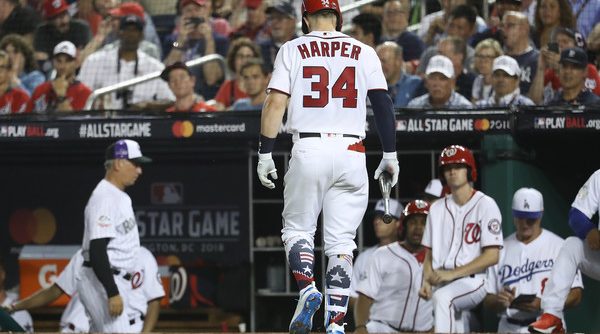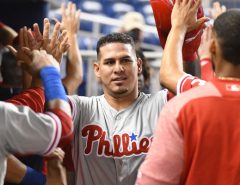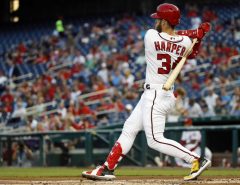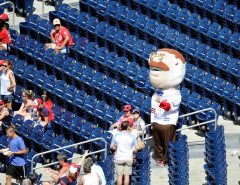What should the Nats do with Bryce Harper? Coming into his walk year, he is posting some unusual numbers: .214/.365/.468. The OBP and SLG are good, if not a bit low for him, but that BA … wow. Is this the player teams are lining up to throw 10 years and $400m at? With the emergence of The Truth (aka La Verdad) Juan Soto, the off-season discussion is rather complicated. Before we throw Bryce out with the bathwater, how bad has he been, really? Is it just that he’s 2016 Ryan Zimmerman, waiting to blow up next year?
Even if Harper continues struggling, he will be the top free agent in this year’s class — with Manny Machado falling in at 1b. Machado, coincidentally, posted numbers at the start of 2017 similar to those Harper is posting now. Machado slashed .230/.296/.445 through the first 83 games. He rebounded to hit .290/.326/.500, similar to the numbers he’s posted the previous three or four years, the rest of the way.
More hope for a Bryce becoming BRYCE! in the second half lies in his peripheral metrics. Even though he is striking out at a career-high rate (24%), he’s still taking his walks (18.8%). What is really interesting is he is hitting the ball hard more often than ever (41.1%) and putting up a career-low soft contact rate (11.3%). The biggest difference between this year and last, when he was close to another MVP before getting hurt? BABIP. This year he is hitting .226 on balls in play — by contrast, his abysmal 2016 BABIP was .263. According to the Beyond the Box Score, Harper averaged .427 from 2015 to 2017 on hard-hit balls. This year, it is down almost 100 points. He is hitting the ball hard more often, with significantly less success. That has to correct itself.
Even if Bryce goes on an MVP-level tear, what do the Nationals do in the offseason? The better Harper does, the better for the Nationals the rest of the year, but the steeper his price tag. The Nationals have five starting-caliber players: Adam Eaton, Juan Soto, Victor Robles (potentially), Michael A. Taylor, and Harper. If they re-sign Harper, the Nats will have to unload two of them —and one of them is not Soto. Trading Robles for Realmuto makes more sense now. However, while Taylor’s Ks have dropped (28.4%) his walks are up (8.2%), his power has disappeared (.373 SLG; .133 ISO). He’s hitting far more ground balls this year than last. He is still a great defensive centerfielder, but so is Robles, and Robles offers much more offensively. Do the Nationals want to bank on Taylor not being an automatic out? Eaton getting healthy brings another dynamic to this team. He gets on base, rarely strikes out, steals, has some power, and is finally healthy. Trading him makes some sense, but after two injury-plagued seasons, and all the Nats gave up for him, the return on investment will be low. Trading Robles will net a much bigger return, but the risk is much higher.
The emergence of young Juan Soto further complicates this question. As a 19-year-old, he is slashing an amazing .301/.411/.517, with fantastic plate discipline (15.8% BB Rate; 19.6% K Rate). He has cooled off some, but he still works walks and every person that has seen or worked with him has praised his adjustments. By contrast, Harper’s first 51 games, he hit .280/.361/.487. The other players who did what he’s doing at 19 are Hall of Famers. If Soto continues to improve, does it make sense to throw $30-$40m a year at Harper?
The holes in the roster will grow given upcoming departures and the replacements are a bit away from being ready. After this year Gio Gonzalez, Ryan Madson, Matt Adams, and Daniel Murphy are all free agents. Anthony Rendon is a free agent in 2020. If the Nationals re-sign Harper, will there be enough left to fill those holes — especially the one that will be left by Rendon? Assuming Carter Kieboom is the heir to Murphy at some point next year, the Nationals do not have the infield or pitching choices that they do in the outfield. Tanner Roark has been a shell of himself and has shown signs of a decline. The Nats could feasibly use two more starters if Hellickson comes back and is effective. Joe Ross is coming off a serious injury. Jefry Rodriguez and Erick Fedde have not shown they can be effective back-end options. Is it more prudent to spend the money on extending Rendon and pursuing Dallas Keuchel, Charlie Morton, or J.A. Happ? The Nationals could still field an outfield of Soto-Robles-Eaton for approximately one-third of the cost, per year, and that would still be a very good trio.
Despite the potential financial burden, one does not simply replace Bryce Harper. He is a generational talent for a reason. His display in the Home Run Derby reminded us all of what he’s capable of. Even in this frustrating season, he has a 119 WRC+. He has more extra base hits than singles: 33 to 36 (33 singles, 14 doubles, 23 HRs). Maybe he spent too much time training with Joey Gallo in the offseason. When Bryce is BRYCE! he is the best hitter in baseball, on par with Mike Trout. His 197 WRC+ in 2015 is one of the best ever — the third best ever if you remove the Steroid Years of Bonds and McGuire (Dick Allen in 1972 and Frank Thomas in 1994). Mike Trout has a career-high 187 right now. Harper is one of the few players who can carry an entire team for a month. It really is a question of when—not if—BRYCE! returns. Do the Nats just ignore that?
The Nationals have a variety of options. However, they need to be sure to make the right decisions. Is Soto a one-year-wonder, or is he this good? Is Robles injury prone, or is he The Next ‘Cutch? Will MAT return to his 2015-2016 form, or will he be a 20 HR-30SB Gold Glove centerfielder? Will Eaton continue to get injured, or will he remain as the spark plug at the top of the order? Is Bryce worth the investment, or just too inconsistent? Those are very difficult questions to answer. Mike Rizzo has a tough job ahead of him.
Tags: Bryce Harper, Nationals, Nats, Washington Nationals




Leave a Reply